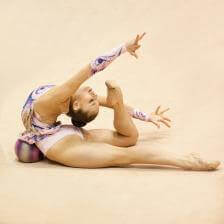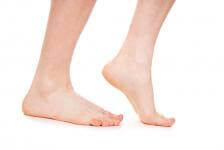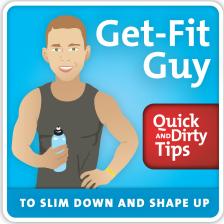Top 10 Stretching Mistakes (Part 2)
In Part 2 of this series on stretching mistakes, we’re going to discuss 5 more errors many people make when stretching that can cause more harm than good. So take a few deep breaths, limber up with a few arm and leg swings, and let’s jump right in!

- stretching knotted muscles
- stretching with poor posture
- stretching yourself into a muscular imbalance
- stretching while stressed
- stretching through pain
Today, we’re going to discuss the last 5 stretching mistakes. So take a few deep breaths, limber up with a few arm and leg swings, and let’s jump right in!
Sponsor: This episode is brought to you by DailyBurn, the best fitness anywhere. Access online workout videos featuring a variety of programs, from tabata to interval training to yoga. Get the first 30 days free when you go to dailyburn getfitguy.
Mistake #6: Stretching Before Strength
It’s no secret that the more limber a muscle is, the weaker it becomes. Just think about a rubber band. A long, stretchy rubber band is far less strong than a tight, springy rubber band.
For example, a recent study on runners found that runners were on average 13-seconds slower when they performed stretching immediately prior to a 1-mile uphill run. So much for those toe-touches before you go tackle the hill repeat! In fact, multiple research studies have shown that static stretching can inhibit the amount of force that a muscle can produce and limit physical performance in just about any jumping, running, or lifting activity you may do after a stretching session.
And if you say you’re just doing stretching before your workout so you don’t get injured, then you should know that further data has shown that static stretching doesn’t even reduce your risk of injury, which is one of the primary reasons that you may have been led to believe you should do it before exercise.
The New York Times recently reported on two new studies that continued to prove the detrimental effects of static stretching pre-workout. The first study showed strength impairments in people who performed static stretching before lifting, compared to those who performed the type of dynamic warm-ups you’ll learn about in just a bit.
The second study looked at a total of 104 previous studies on stretching and athletic performance, and found that in almost every study – regardless of age, sex, or fitness level of the participants – static stretching before a workout decreased performance. This all comes down to the fact that making muscles loose and making tendons too stretchy prior to exercise makes these soft tissue components less above to produce quick and powerful responses.
So if you’re about to lift weights, run fast, or do anything that requires power and explosiveness, don’t do traditional “stretch and hold” style stretching. Do dynamic stretching instead – and here’s how!
Mistake #7: Stretching Without Stiffness

Take the Achilles tendon in the back of your legs below your calves, for example. That tendon needs to be tight and springy in order for you to run fast or jump high – and the fastest sprinters and highest jumpers in the world have been shown to have more tendon “stiffness” in their Achilles tendon, and also their hamstrings, quadriceps, and other big leg muscles.
So how do you make a muscle “stiff”? The answer is plyometrics. In my episode How to Run Faster, I teach you all about plyometrics, which includes exercises like jumping, hopping, skipping, and bounding. If all you do is stretch, without doing these other type of explosive motions, you’re not going to get a good balance of stretching and stiffness.
Mistake #8: Stretching the Back
The one muscle group that tends to get stretched too often is your back. Whether it’s reaching for your toes, doing back bridges, or bending side-to-side, the fact is that you actually don’t need to stretch your back quite as much as you think.
You see, back pain or a lack of mobility in the back is not due to poor flexibility. It’s due to poor flexibility and poor mobility in your pelvic muscles – which limits the range of motion of your hips and makes your back have to overwork – resulting in back injury.
So how do you increase mobility in your hips? Some of the best moves involve lunging, squatting, stepping side to side, and doing hip opener exercises such as clamshells and bird-dogs (don’t you love the names?). The Foundation book I mentioned in Part 1 of this series is also great for teaching you how to have proper pelvic alignment, which can save your back.
Mistake #9: Not Stretching the Feet

See also: How to Get Stronger Feet
All of these activities keep my feet nice and stretchy, which is crucial for the health and mobility of my knees, my hips, my back, and even my shoulders! So no matter how much you stretch or how good your stretch program is, be sure not to neglect your feet. And for crying out loud, be careful with things like high heels, cowboy boots, and tight fitting shoes – all of which can vastly reduce the flexibility and mobility of your feet.
Mistake #10: Stretching Too Simply
Because your muscles eventually adapt to the demands you place upon them, you need to constantly change your workout and fitness routine if you want to become more fit. Stretching is no different – you should always be moving your body in different ways and learning new stretches or new mobility moves that can challenge you.
Some of my favorite resources for learning new stretches include the book Becoming a Supple Leopard, visiting yoga classes at gyms, and trying to make sure it’s not the same teacher every time, trying out different yoga or Tai Chi DVDs, and even trying a variety of phone apps that teach new yoga moves, such as Mind Body Yoga, YOGAmazing, and Office Yoga.
There’s all sorts of new stretch moves that go way above and beyond toe-touching, and this will keep both your body and mind guessing.
Congratulations! You now know everything you need to know about common stretching mistakes! If you have more questions about the 10 stretching mistakes we’ve discussed over the past two episodes, or you have your own ideas to add, then post them in Comments below or at Facebook GetFitGuy.
Feet stretch image courtesy of Shutterstock.







